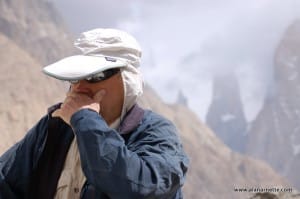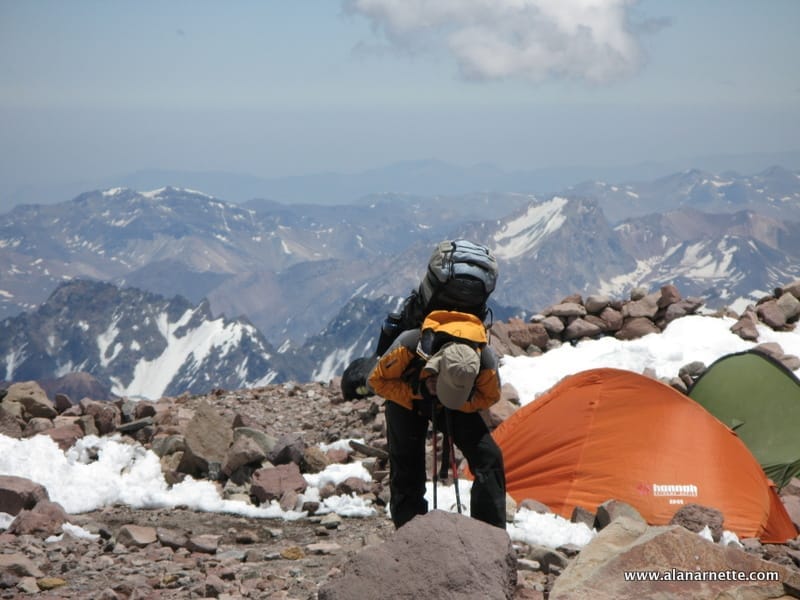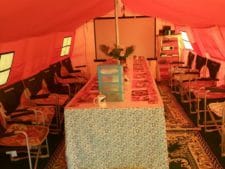For some Everest climbers, they left home a month ago, others are leaving today. But for all, they’re dreaming of summits in a just a few weeks. The season continues smoothly with little issues and good progress on both sides. The weather remains good. Ropes are being set on the Nepal side, soon on the Tibetan side and climbers are moving on their first rotation on both sides.
The Big Picture
About this time each year, climbers on both sides begin to move up the mountain to acclimatize their bodies for the summit push in about three weeks. On the Nepal side, the current focus is to get to Camp 2 around 21,000’/6400m and on the Tibet side it is to get to Advanced Base Camp then a night at the North Col at 23,000’/7,000m. Meanwhile the rope fixers are working hard to set the route as high and as fast as they can knowing that the sooner it gets in, the sooner some teams will push hard to be first to summit while other are content to wait. All of this is good as it reduces the potential for crowds. One of the main reason the 2012 season was chaotic was that poor weather and late ropes narrowed the summit days from the normal 6 to 16 with an average of 11 since 2001, to 4 or 5 causing teams after team to be forced to go along with the crowd.
Thus far it has been normal weather, clear morning with cloud and light snow in the afternoons. The nights are cold hovering around 15F/-10C. But it seems about time for a front to move in so they could be hit with a few weather days soon – all normal for late April on Everest.
First Time Times
The first time to a new camp is always a milestone. For some people it’s the moment they realize they didn’t train hard enough, are not willing to take the risks inherent with climbing or something just doesn’t feel right and they end their dream. For others, they push hard, arrived knackered and wonder how they will ever make higher but they go on. Then there are those who cruise arriving happy, winded and tired but not exhausted. They are the ones that are are both lucky and to be praised for their preparation. Regardless of which profile our climber has, the key is to have a positive experience where new memories are made each moment.
These are the approximate elevations and times between camps on the Tibet side:
- Base Camp: 17,000′ – 5,182m
- Interim Camp: 20,300′ – 6,187m – 5 to 6 hours
- Advanced base camp: 21,300′ – 6,492m 4 – 6 hours
- North Col or C1: 23,000′ – 7,000m – 4 to 7 hours
These are the approximate elevations and times between camps on the Nepal side:
-
Base Camp: 17,500’/5,334m
-
C1: 19,500’/5,943m – 3-6 hours, 1.62 miles
-
C2: 21,000’/6,400m – 2-3 hours, 1.74 miles
Preventable Frostbite
 EverestER, the all volunteer medical organization at EBC, said they have already treated 89 patients, with the usual problems of diarrhea and coughs. However they go on to comment on frostbite and gave a shoutout to Fujufilm for their support:
EverestER, the all volunteer medical organization at EBC, said they have already treated 89 patients, with the usual problems of diarrhea and coughs. However they go on to comment on frostbite and gave a shoutout to Fujufilm for their support:
But what isn’t typical is 4 cases of frostbite already. It’s typically colder at the beginning of the season as we move from winter into monsoon season, but climbers are not at the higher camps yet so what we think we are seeing is preventable cold injury. Several of the patients were wearing boots that didn’t fit properly (any footwear, socks included, that restricts blood flow can create a dangerous situation in cold temperatures and we saw some examples of it this week.) Our docs are alerting base camp managers and leaders to make sure their climbers are aware of the variables that make cold injury more likely – to try to prevent more cases. And our #Sonosite ultrasound saved the day by helping to diagnose a heart problem in a patient and get them down to definitive care.(Thanks Fujifilm SonoSite for the loan)
It’s odd to see frostbite this early and while climbers are still low on the Hill. Normally it occurs during the summit push when temps fall below 0F/-18C and winds gust over 30mph/48kph. I find this disturbing because it indicates a lack of experience by both guides and members. When you go to Everest your boots, gloves, head gear and layers should be totally dialed in. This is why the best guides will require experience on peaks like Denali, Lenin, Aconcagua or better yet Cho Oyu or Manaslu where the member has already been exposed to harsh conditions.
Early Illness

I’ve already highlighted a few people who are sick, some even leaving their expeditions for home already. This is, sadly, not all that uncommon. A lot of people need a few days to adjust to new food and get stomach issues. Another common malady is the dreaded Khumbu Cough caused by bronchial irritation and inflammation secondary to the cold dry air that can easily move into more serious problems. Occasionally a person will break a rib from coughing so violently. The common way to try and avoid the cough is to use a Buff constantly to warm air before it enters the lungs and keep hard candy in your mouth such as Fisherman’s Friend® throat lozenges.
Brian Palmer posts his current experience plus says “My health is more important than a summit.”
Well, I made it to camp 1 where I started coughing up blood and developed a full on throat infection. I stumbled my way back through the icefall this morning and am back at base camp. I am going to helicopter downtown Kathmandu tomorrow and try to recover there. If I can recover I will fly back up to join my team for rotation 2,if I don’t recover…well, I’ve already had a pretty epic experience.
Matt Moniz is also down at the moment with stomach issues:
Hey Everyone! Trying to keep this video blog real, so sharing a little setback today. Must have picked up a hitchhiker in some food or water. Really common for climbers on expeditions to get stomach issues, not the first time for me, so not a big deal but was looking forward to being up a little higher today. I’m out of action for a bit, no Lobuche climb. Upside, I can wait for the skis. It’s about 12 hours difference from the US, may be able to get motivated and climb to Pumori High Camp in a bit.
These two cases and the one on the Tibet side I covered a few days ago is 100% common and has little to do with the quality of the company you are with, even though you will hear “no one on our team gets sick” …. fake news :). Considering the radical change in diet, the altitude where your body is both adjusting while exposed to all sorts of bugs plus having a lower strength in your immune system, getting sick simply happens. They key is to give yourself permission to take time off, rest, hydrate and recover. You can’t do that with “active rest days” or trying to go back up before you are ready. Climbing Everest is a marathon so slow the pace down and enjoy the rest.
Steve Plain demonstrated the solution with this post about him taking an extra rest day:
Rest day in base camp. It pains me to admit it, but today I sat in basecamp and did absolutely nothing. I still don’t feel great, so for once in my life I’m doing the sensible thing and giving my body a chance to recover. Anyway, it’s had a chance now so heading back up the hill tomorrow.
Let’s Eat!
While we are on the subject of food, Simon Thomasson with Nepali based Ascent Himalaya gave a nice summary of their meals today, of course with pictures – vegetarian and non-vegetarian:
So with not much to talk about today I may as well talk about what we’ve had to eat.
For breakfast, porridge, omelette, bacon and toast was on offer. Lunch, chicken burger, fried potatoes, green beans, fried rice, grated carrot, and bananas for desert. Dinner, spicy poppadoms, mushroom soup
????, steak (egg non veggie) rice, chips and veg and canned peaches for desert. This is on top of the endless supply of pringles, chocolates and biscuits that we can help ourselves to throughout the day.
By the way, Ascent Himalaya is one of the Sherpa owned and run companies that are providing good value with a quality climb. Their founder, 48 year-old Mingma Tshiring/Tsiri Sherpa started as a porter and now has over 20 years of trekking and mountaineering experience including 19 summits of Everest. He was also one of the first Nepalese to summit K2 in 1997. They charge $45,000 for Everest from Nepal and $42,500 from Tibet. These are about mid-range prices in 2018.
Tibet Side Moving Up
On the North, teams are leaving today or tomorrow for the Interim Camp then on to Advanced Base camp for a few days. They will try to at least tag the North Col or even sleep there before returning to Chinese Base Camp. Most teams will only do two acclimation rotations on that side. Lukas Furtenbach describes his team’s plan for the next few days, along with some of their base camp luxuries:
The first rotation is also about leaving all the comfort and amenities that BC offers. Heated tents, great Italian coffee, movie evenings, Austrian sausages and famous Mozartkugeln
???? And of course a sauna and infrared cabine from Physiotherm Infrarotkabinen powered with clean energy from New Enerday GmbH. Staying up in the high camps is harsh and demanding. Although you can still enjoy a big dining tent, chairs and tables at C1 at 7000m everything is different and more serious.

He goes on to describe the $117K “Flash” climb that I discussed with him in interview late last year. The highlights are to “pre-acclimitize” in the comfort of your home by sleeping in a plastic bag over your head for weeks on end, then to arrive as late as possible at base camp and take one rotation then climb with 8 liters per minute of unlimited supplemental oxygen along side multiple Sherpas and IFMGA guides. Lukas sys:
Fingers crossed for our classic climbing team for their first rotation. While our Flash team still enjoys spring and summer temperatures at home. Today we sleep at simulated 7000m and do our virtual first rotation to Nort Col. This night will be as bad as the first night on real North Col
????Leaving for Everest soon!
Not to be left behind, Adrian Ballinger’s Alpenglow team is on schedule; AB posts:
Our Everest guide team flies into Lhasa, Tibet today (el. 12,000’ / 3,650 m). From here on out, the elevation will really start racking up! Luckily, our team has spent 8 weeks pre-acclimatizing using the Hypoxico Altitude Training System and is fit for the challenge.
Over the past few weeks, climbers have been decreasing the oxygen levels within the tent to reflect the elevation of expedition base camps. They’ve trained their bodies to create more red blood cells, which aid in oxygen delivery to the muscles and also allows for quicker recovery- effectively reducing the traditional acclimatization time on the mountain and increasing the team’s chances of a successful summit!
As always, best of luck to all – climbing alone, climbing without O’s, climbing late, climbing with Sherpas, climbing the old-fashion way or to those back home sending good thoughts to everyone on the Hill.
I leave you with this video from the Russian outfit 7 Summits Club at their base camp “relaxing” with Wadka, smokes and some interesting music! The party really gets going around 1:40 🙂
Why this coverage?
I like to use these weekend updates to remind my readers that I’m just one guy who loves climbing. With 35 serious climbing expeditions including four Everest trips under my belt and a summit in 2011, I use my site to share those experiences, demystify Everest each year and bring awareness to Alzheimer’s Disease. My mom, Ida Arnette, died from this disease in 2009 as have four of my aunts. It was a heartbreaking experience that I never want anyone to go through thus my ask for donations to non-profits where 100% goes to them, and nothing ever to me.
![]()

This Weeks Posts
- Everest 2018: Active Rest at Base Camp
- Everest 2018: Base Camp Progress and Pujas
- Everest 2018: Into the Icefall
- Everest 2018: April 18, A Day to Remember
- Everest 2018: A Big Year – Again
- Everest 2018: Interview with Matt Moniz – Extraordinary Youth
- Everest 2018: First Climbers into the Western Cwm
- Everest 2018: A Normal Day






